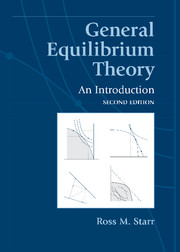Book contents
- Frontmatter
- Contents
- List of illustrations
- Introduction to the second edition
- Preface to the second edition
- Preface to the first edition
- Table of notation
- Table of assumptions
- A General equilibrium theory: Getting acquainted
- B Mathematics
- C An economy with bounded production technology and supply and demand functions
- D An economy with unbounded production technology and supply and demand functions
- E Welfare economics and the scope of markets
- F Bargaining and equilibrium: The core
- G An economy with supply and demand correspondences
- 23 Mathematics: Analysis of point-to-set mappings
- 24 General equilibrium of the market economy with an excess demand correspondence
- 25 U-shaped cost curves and concentrated preferences
- H Standing on the shoulders of giants
- Bibliography
- Index
25 - U-shaped cost curves and concentrated preferences
from G - An economy with supply and demand correspondences
Published online by Cambridge University Press: 05 June 2012
- Frontmatter
- Contents
- List of illustrations
- Introduction to the second edition
- Preface to the second edition
- Preface to the first edition
- Table of notation
- Table of assumptions
- A General equilibrium theory: Getting acquainted
- B Mathematics
- C An economy with bounded production technology and supply and demand functions
- D An economy with unbounded production technology and supply and demand functions
- E Welfare economics and the scope of markets
- F Bargaining and equilibrium: The core
- G An economy with supply and demand correspondences
- 23 Mathematics: Analysis of point-to-set mappings
- 24 General equilibrium of the market economy with an excess demand correspondence
- 25 U-shaped cost curves and concentrated preferences
- H Standing on the shoulders of giants
- Bibliography
- Index
Summary
U-shaped cost curves and concentrated preferences
In intermediate microeconomic theory, a firm's cost function is often described as U-shaped. The notion is that firms producing at low volume have high marginal costs. The marginal costs decline as volume increases and then start to rise again. There is a region of declining marginal costs. But declining marginal costs are inconsistent with convexity of technology, and convex technology is one of the assumptions used to show the existence of general equilibrium in Chapters 14, 18, and 24. Can we reconcile the elementary U-shaped cost curve model with the existence of general equilibrium?
Convexity of preferences was one of the assumptions used to demonstrate continuity or convexity of demand behavior needed for the proofs of existence of general equilibrium in Chapters 14, 18, and 24. But surely there are instances where convexity does not hold. A household might be equally pleased with a blue suit and a gray suit but half a blue suit and half a gray suit is not so satisfactory. A resident may be equally satisfied with an apartment in San Francisco or one in Boston; half time in each is less satisfactory. The household has concentrated preferences (or a preference for concentrating consumption). Can these preferences be reconciled with the existence of general economic equilibrium?
We'll argue in this chapter that the answer is “yes.” Using the Shapley-Folkman theorem we'll establish the existence of approximate equilibrium in these settings.
- Type
- Chapter
- Information
- General Equilibrium TheoryAn Introduction, pp. 312 - 322Publisher: Cambridge University PressPrint publication year: 2011



